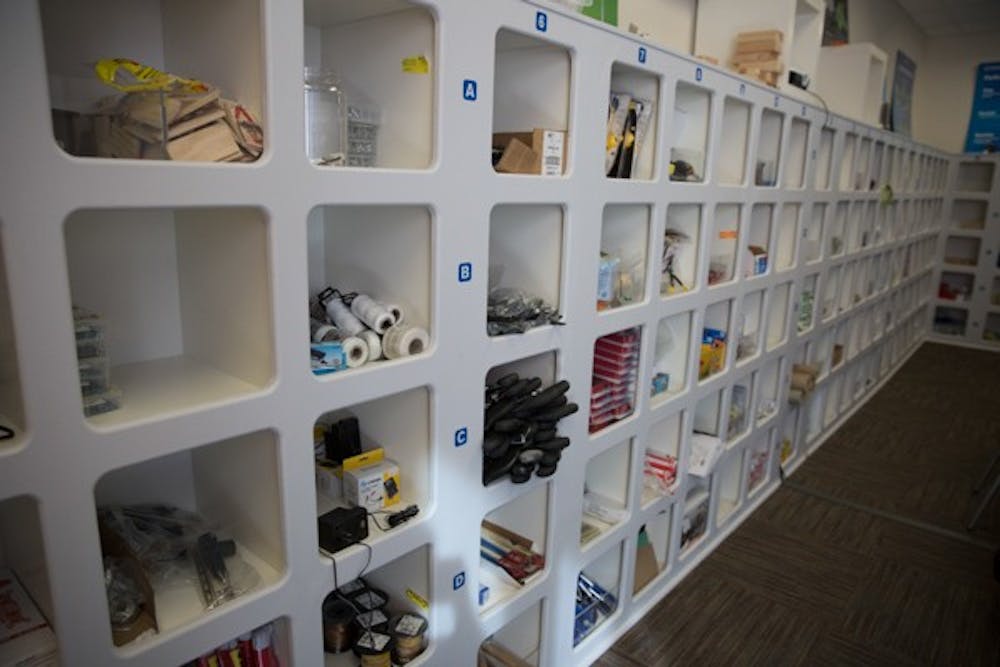 STEAM kit materials at the ASU Polytechnic campus kept in separate bins. (Photo by Carly Traxler)
STEAM kit materials at the ASU Polytechnic campus kept in separate bins. (Photo by Carly Traxler)
ASU engineering professor Shawn Jordan has partnered with the Navajo Nation to host STEAM camps, giving students the unique opportunity to learn and apply chain-reaction and engineering design.
Students use basic principles of science, technology, engineering design, arts and math combined with chain reaction to create machines similar to those produced by cartoonist Rube Goldberg.
“We’re using STEAM camps to teach students engineering design skills and connect them with hands-on projects that are relevant to their everyday lives,” Jordan said.
He also said the challenge does not come in the form of hosting the STEAM camps, but in giving students opportunities to conquer new experiences.
“There are always going to be new challenges that present themselves at each school we host camps at, whether it be the interests of the students, the resources available locally or something else,” Jordan said. “Our instructional team is very good at improvising and being flexible, though.”
Jordan said his work started about four years ago when he judged Navajo Nation science fairs and soon received the Woodside Sustained Community Service Award, which he used to start hosting the camps.
 Assistant professor of engineering in the College of Technology and Innovation Shawn Jordan poses for a photograph in front of the STEAM lab where kits for middle and high school students are assembled to build Rube Goldberg machines. (Photo by Carly Traxler)
Assistant professor of engineering in the College of Technology and Innovation Shawn Jordan poses for a photograph in front of the STEAM lab where kits for middle and high school students are assembled to build Rube Goldberg machines. (Photo by Carly Traxler)
“We wanted to use chain-reaction to get kids excited about engineering,” he said.
He said the partnership grew stronger when he met and connected with Kalvin White, who is the Director of the Dine’ Office of Science Integration.
Jordan said he and White saw very powerful connection points through the STEAM camps.
Jordan said the future focus is to try to develop the curriculum further because Navajo schools plan to adopt the Next Generation Science Standards for K-12.
“We want to look at the intersection between Navajo culture and engineering design,” he said. “Navajo schools now need to figure out a way to teach engineering in addition to the regular science curriculum.”
White said the ongoing partnership gives ASU great exposure.
“The Navajo Nation partners with 14 colleges and universities to offer diverse programs,” he said. “We have had success working with Shawn and others at ASU.”
Although it benefits ASU, White said the partnership also focuses on preparing Navajo students for future careers in engineering or math.
He also said the partnership would not be possible without Jordan’s hard work and persistence.
“We have been able to generate more internships and careers for Navajo students through Shawn’s work and leadership,” White said. “The department is interested in continuing to partner with ASU to create more beneficial programs for Navajo students.”
Dine’ Principal Education Specialist Johanson Phillips, who found schools to host the camps based on student interest in science, said he has seen benefits from the STEAM camps.
 STEAM kit materials at the ASU Polytechnic campus kept in separate bins. (Photo by Carly Traxler)
STEAM kit materials at the ASU Polytechnic campus kept in separate bins. (Photo by Carly Traxler)
“It’s great to have first-hand knowledge of the vast interest in the students due to their participation, use of creativity, and desire to expand their knowledge and interest in this initiative,” he said. “We have heard favorable responses from educational institutions and students who wish to explore professional fields of science.”
Although he said he could not speak on behalf of the Navajo, Phillips thinks the partnership with ASU is positive and could be expanded.
“Our continued work with the ASU Polytechnic school is positive as we both aspire to introduce such initiatives to raise in science in Navajo schools, which are mostly located in rural, non-Wi-Fi locations," he said.
Reach the reporter at Justin.Toscano@asu.edu or follow him on Twitter @justintoscano3.
Like The State Press on Facebook and follow @statepress on Twitter




